Beef prices are projected to continue increasing as U.S. beef production declines with no signs of a cattle herd rebuild. Additionally, cheap beef may soon become further out of reach…
Jan. 1 Cattle Inventory Down 3%, Beef Cow Herd Lowest Since 1962; While China Owned North Dakota Corn Mill Draws Focus
Bloomberg writers Michael Hirtzer and Elizabeth Elkin reported yesterday that, “Steaks and hamburgers will likely be more expensive in the next few years with US cattle shrinking to its lowest herd since 2014.
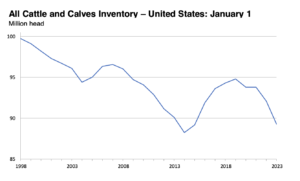
“There were almost 89.3 million cattle as of Jan. 1, down 3% from a year ago, according to a US Department of Agriculture cattle-inventory report Tuesday. While the drop wasn’t unexpected — the total nearly matched expectations in a Bloomberg survey — a bigger decline in beef output may still be ahead in 2025 or 2026.
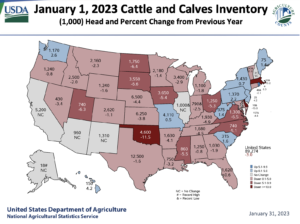
“‘With fewer cattle supplies becoming available, beef production is expected to undergo a sizable decline over the next few years,’ said Courtney Shum, a livestock-market reporter at Urner Barry, an industry publication.”
Hirtzer and Elkin explained that, “Years-long drought in the US Plains has withered pastures and squeezed supplies of feeds including hay and corn. The result: ranchers have liquidated some animals to cut costs, depressing breeding.
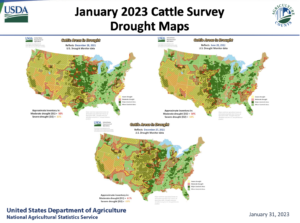
“In Texas, a key cattle state, the USDA said in a separate report that pasture and range conditions ‘are mostly poor due to the lack of moisture and cold temperatures.'”
And Reuters writer Tom Polansek reported yesterday that, “The U.S. beef cow herd dropped to its lowest level since 1962, U.S. Department of Agriculture data showed on Tuesday, after a severe drought raised costs for livestock feed.”
Polansek noted that, “There were 28.9 million beef cows as of Jan. 1, down 3.6% from a year earlier, the USDA said. It was the smallest herd size for that date in 61 years, according to U.S. government data.”
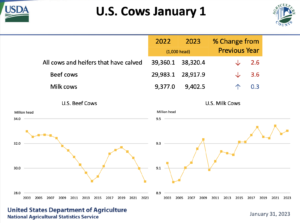
Meanwhile, Bloomberg’s Mike Dorning and Michael Hirtzer reported yesterday that, “The Biden administration introduced a public database on payment terms for private cattle sales, designed to give producers more leverage in negotiating with the four meatpacking giants that dominate US beef processing.
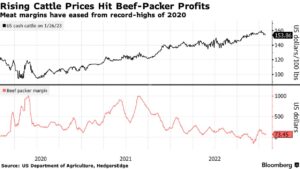
“The Cattle Contracts Library will go live as a pilot project at noon on Tuesday and will disclose terms for all cattle-purchase contracts made by large meat packers, but not the identities of buyers or sellers, US Agriculture Department officials said. That will include how the base price in each contract is calculated and premiums paid for special traits such as prime-grade beef, Angus cattle or hormone-free animals, as well as penalties deducted for less-desirable livestock such as older cattle.”
Also yesterday, Bloomberg writers Ana Monteiro and Brian Platt reported that, “The US set up a second dispute-settlement panel to resolve differences with Canada over its dairy quotas, saying Ottawa is still undermining access to its market under a trade deal between the nations.
“While Canada changed its quota allocations after a panel found in December 2021 that its measures were inconsistent with its obligations under the pact, its new policies “have not fixed the problem,” US Trade Representative Katherine Tai said in a statement Tuesday.”
In other developments, Mitch Smith reported in today’s New York Times that, “After more than a year of debate about whether a Chinese company’s plan to build a corn mill in North Dakota was an economic boon or a geopolitical risk, an assistant secretary of the Air Force has weighed in with a warning that the ‘project presents a significant threat to national security.’
“The letter from Assistant Secretary Andrew P. Hunter, released publicly on Tuesday by North Dakota’s senators, noted the proximity of Grand Forks Air Force Base to the proposed mill and said the project raised ‘near- and long-term risks of significant impacts to our operations in the area.’
“The debate over Fufeng USA’s plan to build a giant milling facility on the edge of Grand Forks, less than 15 miles from the Air Force base, divided the Republican power structure in North Dakota and showed just how swiftly the economic relationship between the United States and China had changed.”
And Wall Street Journal writer Kristina Peterson reported yesterday that, “The mayor of Grand Forks N.D., said Tuesday he would move to halt development of a Chinese-owned corn mill there after an Air Force official called the project a national security risk because of its proximity to an Air Force base.”





